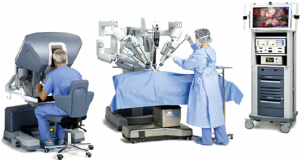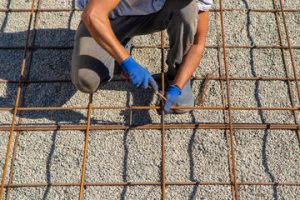A hernia occurs when tissue pokes through a weakness or an opening in the muscle or connective tissue. The tissue may be fat or part of your intestines. Depending on the type of hernia, it can appear as a bulge in your abdomen or groin. It may feel painful or swell when you stand or strain, and it can cause discomfort or numbness that worsens with time. Most hernias require surgical repair. Contact Robotic Hernia Surgery now!
A traumatic injury or surgery can cause hernias, but most develop slowly from years of pressure and stress on your body, especially your abdominal muscles. Obesity can also increase your risk of hernias because more pressure is placed on your stomach and abdominal walls. Having a job that requires heavy lifting or standing for long periods of time can also make you more likely to get hernias.

Most hernias aren’t dangerous right away, but over time they can become stuck or lose blood flow, which is a serious medical emergency. That’s why most providers recommend getting them repaired.
Generally, hernias are treated with surgery, but traditional methods are painful and often lead to long recovery times. Robotic hernia surgery is a less invasive method that can reduce your pain and recovery time.
The da Vinci robotic system allows your surgeon to operate through small incisions rather than one large cut in the area of the hernia. They use a small camera in a tube (laparoscope) and surgical tools that are inserted through the small incisions. The surgeon controls the instruments from a console next to your abdomen. They can bend and rotate the instruments in real-time, which gives them greater control over your hernia repair.
Hernia Symptoms
Most hernias cause a noticeable lump in the affected area. This bulge often becomes larger or more prominent when you lift heavy objects, bend over, cough, or sneeze. Pain or discomfort may also occur.
Hernias can become trapped in the abdominal wall and cut off from blood flow, causing severe and sometimes life-threatening complications. This is called incarceration and requires immediate medical attention.
If the hernia is causing symptoms, your doctor will likely recommend surgery to prevent further damage and relieve pain. Most hernias can be repaired through minimally invasive laparoscopic surgery, which uses small keyhole-size incisions through which a camera and instruments are inserted to make the repairs. However, some hernias require open surgery, which involves more extensive repairs and a longer recovery time.
Robotic hernia surgery is an advanced form of minimally invasive surgery that uses a robotic arm equipped with surgical tools controlled from a console by your surgeon. This allows your surgeon a greater range of motion and visualization for a more precise and efficient operation.
Some hernias don’t cause a visible lump, especially in the case of hiatal hernias (which develop when part of your stomach slips through a hole in your diaphragm during pregnancy) and femoral hernias (which happen when fatty tissue pokes through a weak area near the groin). These hernias may be diagnosed through a physical exam or an imaging test such as X-ray, CT scan, or an ultrasound.
You can reduce your risk of hernias by avoiding heavy lifting, constipation, and smoking. You should also drink enough water and avoid eating foods high in fat or salt, which can increase your risk of developing hernias. If you do experience a hernia, seek medical attention promptly to prevent serious complications.
Hernia Causes
Many hernias form when tissue pokes through a weak spot in the muscle or the tissue that holds it together. This can cause a visible bulge in the area. Generally, hernias aren’t dangerous, but they can get stuck and lose blood flow, which is why most of them need to be fixed surgically. Hernias can appear in the abdomen, groin, diaphragm, or around the belly button. They may be present at birth, or they can develop after surgery, injury, or weight gain.
During hernia surgery, your surgeon will make an incision near the hernia. They will push the tissue back into place, sew it shut, and reinforce the area with mesh. This reduces the risk that your hernia will return, but it’s not a guarantee.
It’s important to choose a doctor with hernia surgery experience and a good track record. There are risks associated with all surgical procedures, including anesthesia, infection, bleeding, and damage to surrounding tissues. It’s also possible that the robot will malfunction, though this is rare.
After hernia surgery, you’ll need to rest and take it easy for several days. During this time, you should avoid strenuous activity and heavy lifting. If you follow these instructions, your hernia should heal quickly, and you’ll be back to your normal life in no time.
Hernia Treatment
Your surgeon may recommend surgery to prevent complications and relieve pain from hernias that don’t go away on their own. Your doctor will order blood tests and imaging to help ensure you’re healthy enough for hernia repair. You’ll need to stop taking certain medications before surgery, like aspirin, unless instructed otherwise. You’ll also need someone to drive you home after the procedure.
During surgery, your doctor will make a single cut (several inches long) for open hernia repair or several small cuts (three to four, no longer than an inch or so each) for laparoscopic hernia repair. Then, they’ll push the herniated tissue back into place and repair the weakened area. They may place mesh, which supports the surrounding tissue and helps prevent future hernias. Finally, they’ll suture the wounds.
Robotic hernia repair uses a console-controlled surgical robot, which gives your surgeon more precise movements and improved visualization. However, your surgeon is in control the entire time.
Once the surgery is complete, you’ll need to stay in the hospital for a few hours while you recover from the effects of anesthesia. Your doctor will give you pain and antibiotics to address any surgical-site infections. After you’re ready to leave, your nurse will teach you how to care for the incision site and keep it clean. You should avoid strenuous activities and lifting heavy weights until your doctor says it’s safe to do so. A follow-up appointment will be scheduled to check your progress. Most people can return to work and resume daily activities within a few weeks. If the hernia reoccurs, your doctor may suggest a more aggressive treatment plan. This could include a mesh implant or other techniques that require more recovery time.
Hernia Surgery
Millions of Americans develop hernias, and while most are harmless, some may require surgery. Traditional hernia surgery is invasive, long and painful, and can lead to complications and recurrences. Robotic hernia surgery is less invasive, typically shortens recovery times and causes less pain. It also carries a lower risk of hernia recurrence than traditional surgical methods.
During robotic hernia repair, surgeons use the da Vinci system to perform abdominal wall reconstruction and hernia repair through a few small incisions. The surgeon sits at a console next to you, operating through tiny instruments, including a camera, which gives them a 3D high-definition magnified view inside your body. They control all of the instrument’s movements, and every hand movement is translated by the robot in real time to bend and rotate the tools with precision.
With the ability to manipulate the tools with greater range of motion and a larger articulation at the tips, the surgeon can do tasks that would be difficult or impossible with laparoscopic techniques. This includes advanced procedures such as hernia reduction and transverse abdominis release, which were previously performed with a large incision.
In one study, robotic hernia surgery was shown to be as effective as laparoscopic hernia repair for reducing hernias and their symptoms. However, the higher costs associated with robotic hernia surgery could impact its availability and use if it doesn’t improve outcomes in health care systems with diagnosis-related groups (DRG) reimbursement models.



